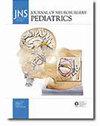Is initial unilateral revascularization acceptable in pediatric patients with bilateral moyamoya disease with mild contralateral hemodynamic disturbance?
IF 2.1
3区 医学
Q3 CLINICAL NEUROLOGY
引用次数: 0
Abstract
OBJECTIVE Although asymmetrical vascular involvement between hemispheres is common in pediatric patients with bilateral moyamoya disease, whether hemispheres with mild vascular changes and hemodynamic impairment require immediate surgical revascularization or whether they can be observed until disease progression remains unclear. The authors evaluated the long-term outcomes of their strategy to initially perform unilateral surgery and withhold surgery to the contralateral hemispheres with mild vascular changes and hemodynamic impairment. METHODS The authors retrospectively evaluated Japanese pediatric patients (onset age ≤ 15 years) diagnosed with bilateral sporadic moyamoya disease who underwent unilateral revascularization. The authors investigated whether the patient underwent additional collateral surgery and the incidence of ischemic events during follow-up. They also compared visual assessments of arterial spin labeling (ASL) images obtained before initial surgery, before additional contralateral surgery, and at last follow-up. RESULTS Overall, 30/47 patients (63.8%) experienced progression of hemodynamic impairment in the contralateral hemisphere and underwent additional surgery. The age at initial surgery of the patients who needed additional contralateral surgery was significantly younger than that of the patients who did not require contralateral surgery (mean [SD] 7.0 [3.0] years vs 9.8 [2.6] years, p = 0.002). One patient (age 4 years) developed ischemic stroke before admission for preoperative evaluation 2 months after novel symptom onset, and another patient (age 6 years) experienced ischemic stroke in the contralateral hemisphere while discontinuing antiplatelet agents before surgery; both patients fully recovered from the neurological deficits. In contralateral hemispheres that required additional surgery, the ASL visual assessment scores significantly decreased before the additional contralateral surgery compared to those obtained before the initial surgery (p = 0.008). CONCLUSIONS In pediatric patients with bilateral moyamoya disease, withholding surgery for hemispheres with mild vascular changes and hemodynamic impairment is generally safe. Younger patients were more likely to experience contralateral progression and require additional surgery, so close follow-up is needed. ASL imaging is useful for detecting and following the progression of hemodynamic impairment in conservatively treated hemispheres.对于患有双侧 moyamoya 病且对侧血流动力学有轻度障碍的儿科患者,是否可以接受最初的单侧血管再通术?
目的虽然在双侧莫亚莫亚病的儿科患者中,半球间不对称的血管受累很常见,但血管病变和血流动力学损伤轻微的半球是否需要立即进行血管重建手术,还是可以观察至疾病进展仍不清楚。方法作者回顾性评估了被诊断为双侧散发性 moyamoya 病并接受单侧血管再通手术的日本儿科患者(发病年龄小于 15 岁)。作者调查了患者是否接受了额外的侧支手术以及随访期间缺血事件的发生率。他们还比较了初次手术前、追加对侧手术前和最后一次随访时所获得的动脉自旋标记(ASL)图像的视觉评估。结果总体而言,30/47 例患者(63.8%)的对侧半球血流动力学损害有所进展,并接受了追加手术。需要对侧追加手术的患者初次手术时的年龄明显小于不需要对侧手术的患者(平均[标码] 7.0 [3.0] 岁 vs 9.8 [2.6] 岁,P = 0.002)。一名患者(4 岁)在新症状出现 2 个月后入院进行术前评估前发生缺血性中风,另一名患者(6 岁)在术前停用抗血小板药物时对侧半球发生缺血性中风,两名患者的神经功能缺损均已完全恢复。结论对于患有双侧 moyamoya 病的儿童患者,如果半球有轻微的血管病变和血流动力学损伤,暂缓手术一般是安全的。年龄较小的患者更有可能出现对侧病变进展并需要再次手术,因此需要密切随访。ASL 成像有助于检测和跟踪接受保守治疗的半球血液动力学损伤的进展情况。
本文章由计算机程序翻译,如有差异,请以英文原文为准。
求助全文
约1分钟内获得全文
求助全文
来源期刊

Journal of neurosurgery. Pediatrics
医学-临床神经学
CiteScore
3.40
自引率
10.50%
发文量
307
审稿时长
2 months
期刊介绍:
Information not localiced
 求助内容:
求助内容: 应助结果提醒方式:
应助结果提醒方式:


